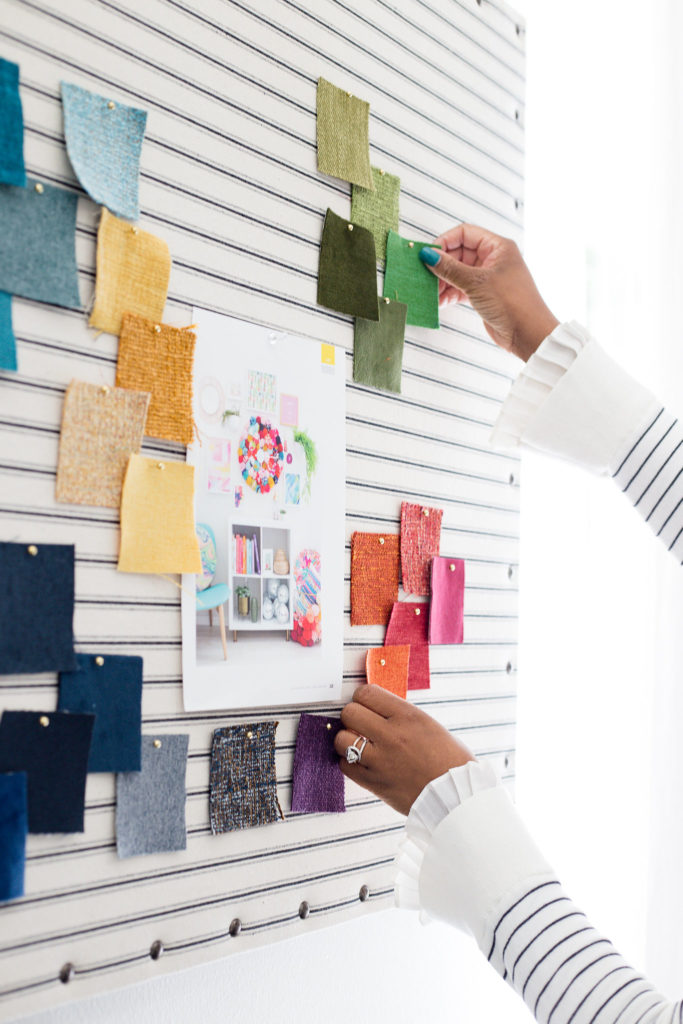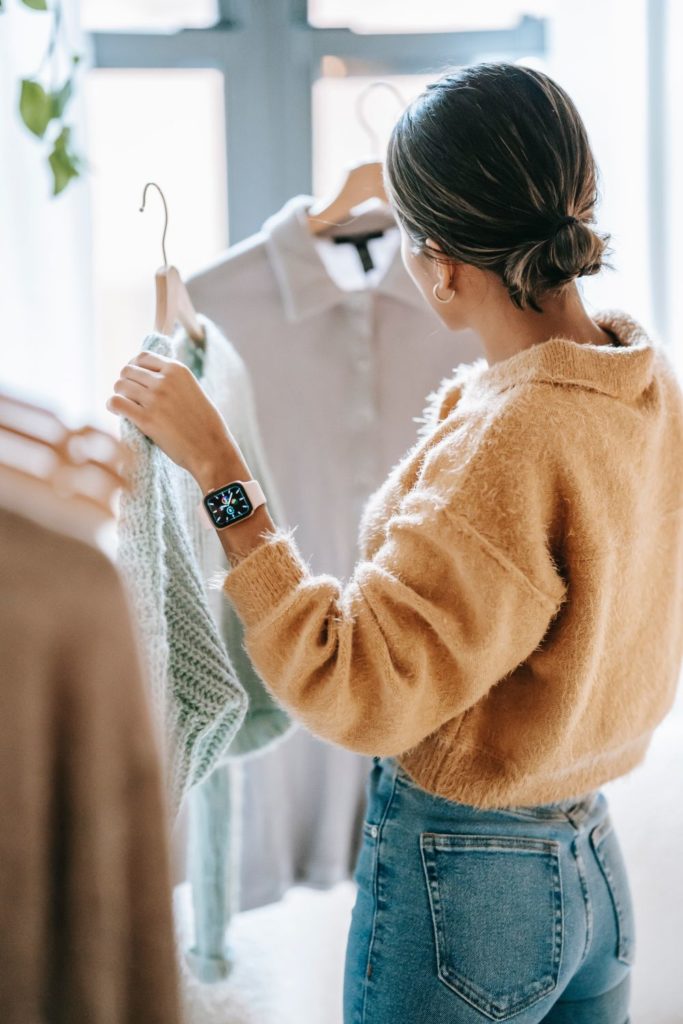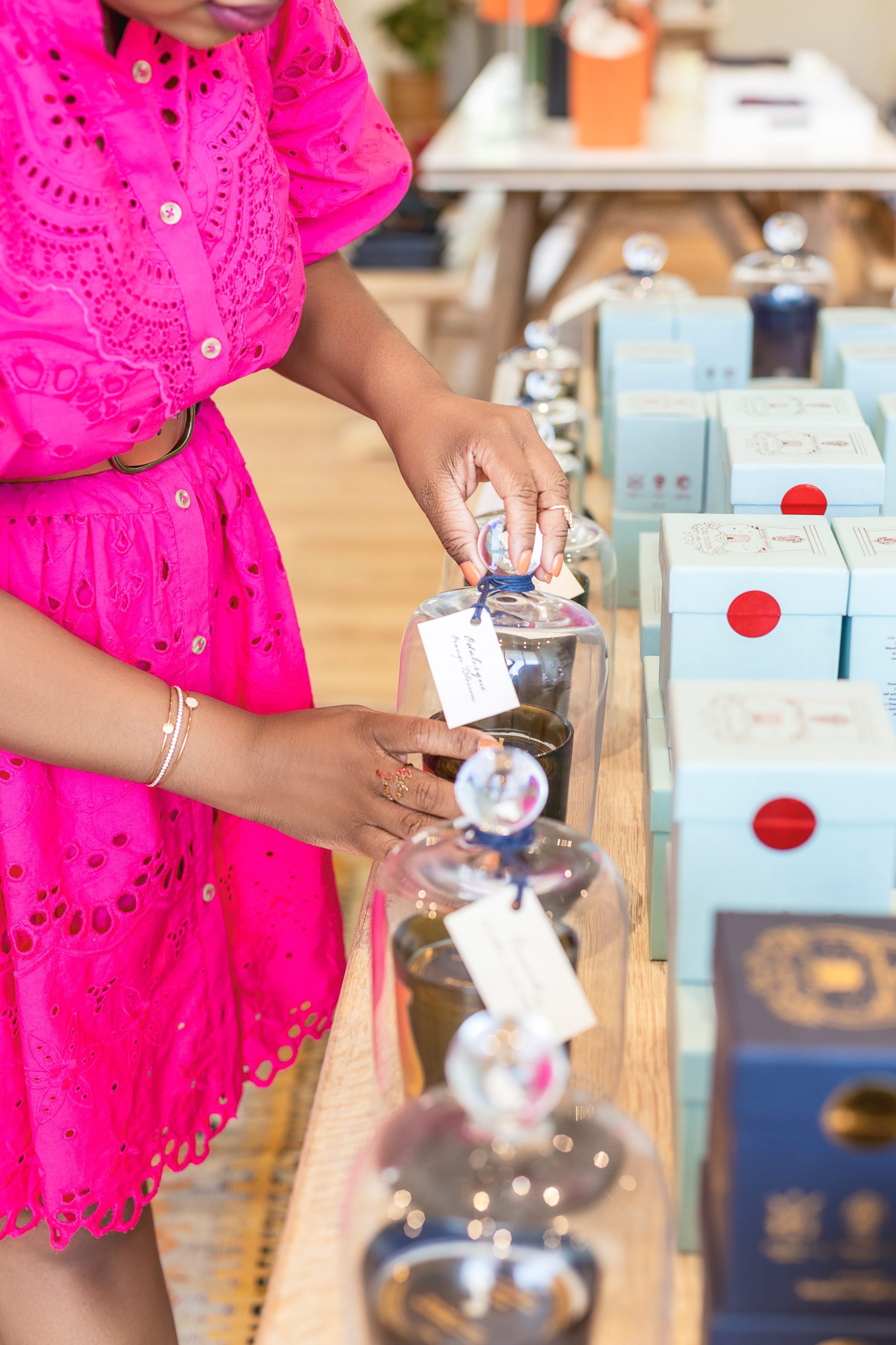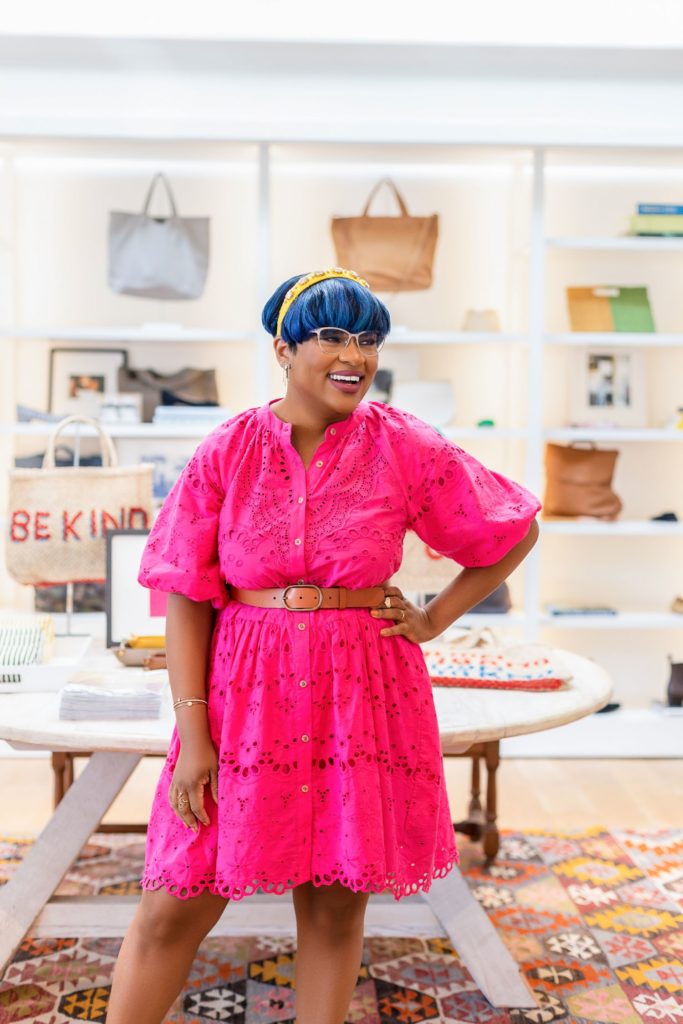Five alarming things Google won’t tell you about launching a store.
Well, there are so many things that Google doesn’t tell you about it, but I’m going to share just five of those things with you today, and also share some of my story to give you some more insight into what you need to know before starting a store.
If you’re ready to get started on your store launch journey now, click here to join me for the Storefront Discovery Intensive.
A glimpse into my experience, as a newbie in the fashion industry.

Now, I came into this industry, obviously because I love fashion, but I didn’t understand the depth of the business behind the industry. Even today. If I tell somebody that I work in retail, they either think that I’m a Sales Associate or a Fashion Designer, which I am neither, but going to school for merchandising, especially at the Fashion Institute of Technology (FIT), gave me an early look at what the Business of Fashion would be like. But I had no idea how complex it was, with so many layers and teams coming together to make just one single product happen. And being new to something is scary.
Quite frankly, most people who end up in the retail industry, as I mentioned in an earlier episode, just stumble into it versus actually having the intention to be a part of this industry from a young age like I did.
I absolutely dealt with imposter syndrome and questioning my every move when I first got started. But I knew that I had something to bring to this industry that no one else did.
No one else had my eye, combined with my cultural experiences, the same way you do. Right?
Nobody else has anything that you have. Nobody has your eye or your experiences.
I wanted to help retail evolve and breathe some life into it. And corporate retail can be just so stale, which is why I left. I just knew there had to be more. There had to be more to this industry.
First came probation.
Well, I’m sure you remember your first job out of college and how it was like a reality smack in the face, right? It definitely was for me. Well, hopefully, you receive some type of on-the-job training to help you be successful.
That wasn’t the case for me. I received about a week of training, and then my manager sent me off to fend for myself. Because I didn’t have that real-life experience in the retail industry, I didn’t have an understanding of how all the moving pieces work together, so I made little mistakes. Luckily they weren’t mistakes that cost the company money, but more training would have absolutely helped.
And long story short, my boss refused to spend any more time training me and they put me on probation. They moved me to another team – crazy, right? I hope that was not your story.
Then I was moved to a new team and had my aha moment.
But on this new team that I was moved to, I received training – not just on the tactical things about running a retail business, but I was also trained to develop my understanding of actual retail business concepts.
So no longer was I just in charge of managing samples, which we all hated as assistant buyers. So I wasn’t just in charge of managing samples.
My new perspective was – I was in charge of making sure that everybody on our team was on the same page with the items that we were bringing in each season.
I no longer looked at pulling sales reports as an annoying thing to do every single day. But instead, I looked at it as I was in charge of providing the data that could drive a million-dollar business decision.
My aha moment was when I discovered that every task within a retail business is interconnected.
DeAnna McIntosh
From that day forward, I was determined to look at the retail business, and my potential in it, from a higher perspective.
And that’s what I challenge you guys to do every single day.
Everything that I do, everything that I say, challenges you to look at the business from a higher perspective.
So for me, in that moment, the daily things that I did were no longer tasks to me, they were steps to get to the end goal that I wanted, which was to change the retail game.
My work proved the case for certain decisions to be made, as do yours. Still, as a newbie to this industry, I was not always taken seriously. Most of the time I wasn’t, but I wanted to prove to myself that this was the path for me after all. I mean, heck, I had been talking about it and convincing my parents of it. So I needed to convince myself too, right?
But you know, I cried so many nights for months questioning what in the entire world was I doing? What was I thinking, going to school for fashion? Like, is this really what I should be doing?
And next, I discovered a ground-breaking fabric.
So I was working in the No-Iron Woven Top Category at the time, which is a really hard category to make sexy.
It’s those little bit stiff button-up shirts. You see them a lot in men’s wear. And we offered it at my company. You know, I was just determined to prove that I could not only contribute fresh ideas and products but that I could also make the company money. I worked with my manufacturer for months researching new fabric technologies in that no iron category.
And I found something I thought was revolutionary, which was no-iron linen.

You know how annoying the linen fabric is and how you just sit down and instantly there are wrinkles everywhere. Right? So no-iron linen, hello, no brainer. Well, I had to pitch my idea of no-iron linen to my team and to the president of the company to convince them to let me do a test of this item.
Well, eventually, after much begging, they approved it.
And my little test did a million dollars in sales.
Little ole me, barely 24 years old, who they put on probation and didn’t want to train, just made them a million dollars.
And now eight years later, that collection is still around, it’s trademarked, and it’s a multi-million dollar program. I used the launch plan that I created for that same collection to create many more profitable collections after that for the company and for other companies.
In that moment, I realized that without the training I received in the business of retail, which helped me to put my work into a different perspective, my career and success could have been over before it even began.
I wondered how many other people had been in the same situation in their jobs just starting out after college.
As a result, I changed my mindset to be that every single task that I do in business is tied to a dollar sign, because it was true.
But the only way that is true is if there is a strategic plan in place. Having a plan for your business operations is a non-negotiable – period. But, especially when launching a new collection or a new store, so that you’re making sure that every decision that you make, makes you money. That’s the goal.
So as I continued on in my career, I began traveling to trade shows, working inside wholesale showrooms, visiting local markets. And that all gave me a glimpse into this whole retail world, but also into the big piece, largely missing from it, which was small businesses.
I started to see that the innovation that this industry needed comes directly from you. You curate the immersive customer experiences. You make unique and trendy products. You also make up 98% of all retail companies.
So I became fascinated with small retail businesses and I started initiatives to bring indie brands into the large retailers.
I landed 13 indie brands into Office Depot stores for the first time in company history.
Well, I worked with Office Depot to bring in 13 indie brands into their stores for the first time in company history. But when working with these brands, I realized how little they actually knew about the business of retail.
It was so frustrating for me to see so much potential in these brands and their businesses, but the lack of industry knowledge held them back.
Oh my gosh, there was so much money left on the table because these brands were not ready to do business. I helped as many brands as I could and landed them, you know, five-figure purchase orders. But it was at that point that I decided to leave corporate retail, pack the strategies I learned and successfully implemented into my Storefront Success® System, to help small business owners launch and build brands that will be marketable and profitable from the start, and that we will still be talking about for years to come.
That is literally my goal in everything that I do.
3 Things That May Be Holding You Back From Launching Your Store
1. Fear of the unknown
So there are so many conflicting information sources out here about how to launch your own boutique.
Some people say you don’t need any money to launch a store, which is a lie.
Some people say you don’t need inventory to launch your boutique, which is a lie too.
Sure you can dropship inventory, but that’s a short-term business model.
And if you don’t know anything about me yet, still know this, I don’t teach nor give short-term or “quick money” strategies. That is not me and it never will be.
When I talk and take my time to get to know you and your brand and give you strategies, it’s to make sure that you’re going to be here 5, 10, 20, 50 years from now.
DeAnna McIntosh
Dropshipping inventory is not a long-term business model.
I know that there’s just so much information out here about how to launch your own boutique on these interwebs, it’s hard to sort through.
2. The outside noise could also make you become overwhelmed with where to start, what steps to take, and in what order regarding how to launch your own boutique.
Maybe you don’t know how much money it’s going to take for you to launch, or you don’t know if right now is the time to launch.
We’re still in this COVID season, but let me tell you, it absolutely is the best time for you to launch.
- Number one: There are more grants and opportunities for small businesses than ever before.
- Number two: Unfortunately, there are stores that have closed, but fortunately for you, their customers are now fair game for you to take.
- Number three: You’d be launching into this COVID impacted environment already knowing how to deal with it versus having to scramble to adjust to it like a lot of business owners still are.
3. Honestly, maybe you’re just scared to pull the trigger and launch your store.
That could be it too. Right?
Well, it’s so important to have a plan and to know about what you’re actually launching.
One of my clients came to me because is a super smart engineer and knew nothing about retail, but he knew all about the tech side of things – and his business combined fashion and tech. So he came to me to learn about the retail side of the business and to have me build out his store launch business plans. I helped him build his store financials to project what they could possibly do in sales after the store launch its’ first year, and future years.
Through our work together, my Store Launch Client was able to raise $120,000 in his first pitch to his investors.
Amazing, right? His story is all about launching with a plan.
“Launch before you’re ready” is something countless people say, and I don’t completely agree with. If you want to maximize revenue and minimize wasted money – launch when the time is right. Launch when you have a plan.
DeAnna McIntosh
Without a plan of how to launch your own boutique:
- You could waste thousands of dollars on inventory that won’t sell, because you didn’t have a buying plan
- You might not buy enough inventory, which means you aren’t making enough money because you didn’t have a sales goal or plans
- You may have to redesign your website because you designed your original website without knowing who your target customer was
- You could also waste money on marketing and ads that don’t convert because you don’t even have a conversion target
- You could also waste money by trying every tech and software out there just to figure out what works
- And you can also lose time
Launching your store without a plan costs you time.
How much is your time worth? How many other things or people are vying for your time in addition to your store?
I’ll tell you for me, in the season of being a new mom, my time is everything. I have half the amount of time every day that I did before, and it is a challenge, so anything that’s going to save me time and get me straight to my goals I will invest in.
Here are 5 alarming things Google will not tell you about how to launch your own boutique.
1. Making $100,000 in retail sales is like flipping burgers at Mcdonald’s.
Read it again. Making $100,000 in retail sales is like flipping burgers at McDonald’s.
Every time I ask someone who wants to start a store, “how much in sales do you want your store to do?”
Everybody’s first response is “six figures / a hundred thousand”. And then I tell them that’s equivalent to flipping burgers at McDonald’s.
You have to think about the net profit.
So that’s after all inventory, taxes, and expenses come out from your sales. What is left?
Making six figures in a retail business is not the same as making six figures in a service business.
And I see so much out here, so many of these “coaches” talking about helping you to get to six figures / $100,000 in your boutique.
Anytime somebody says that to me, I immediately say, you’re not thinking big enough.
So let’s break it down:
$100,000 in revenue – half of those sales go to your inventory.
Now you’re at $50,000. I don’t know how much you make in your full-time job, but I would guess that you make more than $20,000 a year.
$20,000 would be lucky for you to have leftover as your net profit after all expenses and everything is taken out of your revenue.
You can’t take a salary by making a hundred thousand a year after launching your store.
Sorry to tell you, but I’m always going to be honest and transparent. I want you to know what you’re getting into. And retail can absolutely be a profitable business if you know what you’re doing and if you have a plan.
According to Investopedia, Amazon had a net profit margin (net profit is after all expenses are taken out) of less than 2% for several years prior to 2018. So if Amazon made a $100,000 last year, they only had $2,000 left over after everything was said and done.
Now, do you know what I mean?
Now, the average retail net profit margin for small businesses should be much higher than 2% should be maybe 12%, but this helps you put things into perspective.
When we layout your launch plan, we create a financial goal and then break that down to the lowest level to see what your net profit margin will be after everything is taken out.
So if you want to make $100,000 after launching your own boutique, fine, but know that half of that is going to go to inventory expense in that first year.
2. Retail is all about the flow of inventory.
You need to have funding to start and continue.
Customers are going to come back to shop with you for newness, not for the same old, same old.
If you’re only planning for enough money to launch, and not to continue, you won’t have money to bring in new items as often as you need to.
The amount of inventory you invest in your store is directly tied to how much you can make in sales. You cannot make money on inventory you don’t have.
DEANNA MCINTOSH
And I’m sure you’re thinking, well, I could just do pre-orders – that’s only going to get you so far. Most customers don’t like pre-orders. They think it’s annoying.
Think about you, as a shopper. You want something now.
Amazon has conditioned everybody to want now, now, now, now.
So if you’re telling me I have to pre-order something and I can’t get it for a month or more, you’re giving your competitors room to sweep in and take your customers, right? So again, you cannot just think about launching.
You have to think about launching AND running your store.

Your launch plan we create together will tell you how much inventory you will need to buy every month. You’ll know, I need X amount of dollars to start, but I also need X amount of money to continue for the next three months after that – and that’s what you need to aim for at the very minimum.
Alright, so that’s number two. Retail is all about the flow of the inventory. You have to have funding to start and continue.
3. There is no such thing as testing the waters in retail.
Number three is piggyback on number two. With launching a brick-and-mortar store, testing the waters is obviously not even possible because you have to have enough inventory when launching your store to fill up the space, but a lot of people start e-commerce stores thinking that they can launch and “see what happens”.
Trust is critical in online retail. If I come to your site and I only see a few pieces, I’m going to immediately know you’re not serious about this business. I won’t even trust you that you’ll ship my order, if I even place one. People can also tell if you’re just a dropshipping site, which causes trust to die as well.
As I mentioned, with point number two, you have to have funding to start and continue.
That means you can’t just slap up something on your website to test the waters and tell me, “Oh, I’m just buying to see what sells. And then I’ll buy more” because nobody’s going to buy any more!
Why?
Every time they come back to your site, there’s not going to be anything new because you’re still sitting here waiting for people to “buy the inventory you have so you can buy more”. In that time window, people are coming to your site and leaving because they’re saying, “this boutique has the same inventory from the last time I visited a month ago. Nope, not coming back here. I have no reason to. There are a zillion other stores out here”.
DeAnna McIntosh
So that’s why number three is, there’s no such thing as testing the waters. Don’t listen to people who say that.
The other reason is testing the waters is not going to help you hit your sales goals after launching your boutique.
If, you want to hit $10,000 a month. Well, I hope you have at least $5,000 in inventory to make that happen.
Now you can’t test the waters when buying wholesale, which leads me to my next point.
4. Buying wholesale is not the same as shopping at the mall.
I know it’s so glamorized to buy products for your store at tradeshows, but this is what trips up most boutique owners.
The number one question I get from new shop owners is where do I find vendors? Or I’m asked about attending trade shows, but did you know – and Google won’t tell you this – that there are plenty of wholesalers who refuse to sell to online-only stores?
It’s because of the fact that since it’s fairly easy for someone to start an e-commerce store (obviously, they think it’s easy if they don’t know the business of retail because they’ll find out really quickly once they start that it’s not!).

But since it’s fairly easy for somebody to start an e-commerce site, they come to the trade shows, shop around, talk to the vendors, but they don’t know how buying wholesale works. So then they place an order.
When the vendor goes to ship and collect the payment for that order, the shop owner cancels it. This has left a really bad taste in a lot of vendors’ mouths, so some of them refuse to sell to online-only boutiques because of it. If you haven’t launched your store already, some don’t even trust that you’re going to launch at all and they will not sell to you.
There are also minimum pieces per style that you have to purchase when you buy wholesale inventory. And there are usually minimum total order amounts each time you place an order.
This goes right back to my previous point about you not being able to test the waters.
You can’t test the waters if there are minimum pieces per style, and you have to have a cohesive collection with a good amount of skus on your website for people to trust you and to be able to shop effortlessly – or you’re just going to look like a mishmash store.
So again, number four, buying wholesale products is not the same as shopping at a mall.
There’s a whole industry behind retail. There are protocols. There’s a way to talk and negotiate with vendors. There’s a process here and the vendors will know immediately if you know what you’re doing or not. And that will tell them whether or not they even entertain doing business with you.
5. Being successful in retail is about 70% numbers and strategy and 30% buying products.
You’re not going to like me for this one. And I would even venture to say it’s higher than 70%, but I’ll be nice.
The biggest mistake store owners make when launching their store is only focusing on the products and not the numbers behind them.
DeAnna McIntosh
Numbers tell you everything. The more you understand them, the more you will love them. I promise.

In the launch planning process, we go super deep into the numbers so that you’re crystal clear about how much you want your store to do in sales your first year, how much in inventory that will require, and how many customers you need to get inside your brick and mortar store or your online boutique every single hour to hit those goals.
People often think you can slap up an e-commerce website and you know, “launch and they will come”.
Who will come?
You hear that?
Crickets.
NO ONE. NO ONE, will come.
You have to spend money to market your store. People are not just going to find you because you’re posting on Instagram. That’s not good enough. You, you have to advertise. And here’s some context. One of the top stores on Shopify does $115 million a year. Guess how much he said spends on ads every day? $15,000.
$15,000 ad spend to get to $115 million in sales a year.
Does that tell you anything?
The other thing to keep in mind about e-commerce stores is that conversion is low.
Your conversion rate is the number of people who come to your website or come inside your brick and mortar store, in comparison to the number of those people who actually buy. The conversion rate on average for e-commerce sites in retail is less than 3%. And a lot of small businesses I talked to before we started working together are at a 1% or less conversion rate. That means if 100 people came to their site, only one on average will buy.
DeAnna McIntosh
Imagine how much marketing these Entrepreneurs are having to do just to have only 1 – 3 people purchase?
There are things that you can do to improve that conversion rate, which I help you with. But again, on average it’s 3%. For brick and mortar, on average it’s about 20%.
Brick and mortar retail is definitely more profitable than e-commerce, but I’m not going to go there today! The point is though, you must have these things in mind when you’re launching your own boutique.
These are the things that these other “gurus” or “experts” won’t tell you. They’re going to tell you whatever they want to tell you so that you’ll buy whatever they’re selling you.
I’m always going to tell you the truth because I actually care about this industry. I have deep, extensive knowledge of it and even have a degree in it. I’ve been in retail since I was a teenager, and I’m passionate about making sure you’re successful in it too.
To be successful in retail, you have to know the things that Google simply won’t tell you.
You have to know how much money you want to make in your first year, how much inventory it’s going to take to get there, how much marketing it’s going to take to get there, how much expenses are you going to have to spend.
These are all the things that you want to know before you spend a dollar into launching your own store.
Invest in understanding the business behind the business that you’re trying to open so you can make sure that it’s the right decision for you.
And there’s nothing wrong If you decide it’s not the right move for you, that’s something you want to know.
You can invest in knowing that something’s not for you before you invest tens of thousands of dollars, right? That is being a smart entrepreneur.
I want to encourage you that you already have what it takes to launch your own store.
You already have the dream inside of you.
You have the vision.
You just need the step-by-step blueprint on how to get there.
So take the next step and get started launching your store today.
Click here to jump right into the store planning process with me at the next Storefront Discovery Intensive where you’ll get direct answers from me about every single thing I mentioned above.
Happy Launching!


+ show Comments
- Hide Comments
add a comment